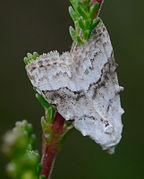bio.wikisort.org - Animal
Nola aerugula, the scarce black arches, is a moth of the family Nolidae. The species was first described by Jacob Hübner in 1793.
| Nola aerugula | |
|---|---|
 | |
| Adult | |
| Scientific classification | |
| Kingdom: | Animalia |
| Phylum: | Arthropoda |
| Class: | Insecta |
| Order: | Lepidoptera |
| Superfamily: | Noctuoidea |
| Family: | Nolidae |
| Genus: | Nola |
| Species: | N. aerugula |
| Binomial name | |
| Nola aerugula (Hübner, 1793) | |
| Synonyms[1] | |
| |
Subspecies
- Nola aerugula aerugula
- Nola aerugula holsatica Sauber, 1916 (Denmark, the Netherlands)
Many authors consider holsatica to be a full species.[2]
Distribution
This species can be found in most of Europe, east to eastern Asia and Japan.[3] [4] It is a rare migrant to Great Britain.
Habitat
This species lives on sandy areas and peatlands.
Description
The wingspan is 15–20 mm. These small drab moths show quite variable colors and patterns. The basic color may be gray, brownish or almost white, with brown transverse bands. There are also bright and dark specimens with high-contrast patterns. Forewings are almost triangular with a rounded basal area. The rear wings are gray or brownish. The body is cylindrical. The antennas are filamentous, about half as long as forewings.

Biology
Adults are on wing from June to August in one generation.[5] Males begin to fly just before sunset, and can sometimes be seen in swarms in search of females. The larvae mainly feed on Trifolium and Lotus corniculatus, but also Betula, Salix and Populus species.[5] The larvae of ssp. holsatica feed on Genista anglica and Genista pilosa. Larvae can be found from August to June.[6] They overwinter. Pupation takes place in a cocoon which can be found on the ground or attached to the host plant just above the ground.[5]
Gallery
- Moth
- Mounted specimen
References
- "Art: Nola aerugula - vitpucklig trågspinnare". Dyntaxa. (in Swedish)
- GBIF
- Fauna Europaea
- Savela, Markku (May 18, 2020). "Nola aerugula (Hübner, 1793)". Lepidoptera and Some Other Life Forms. Retrieved August 6, 2020.
- Lepidoptera of Belgium
- Euroleps.ch
External links
- Lepiforum e. V.
- Mazzei, Paolo; Morel, Daniel & Panfili, Raniero. "Nola aerugula (Hübner, [1793])". Moths and Butterflies of Europe and North Africa. Retrieved August 6, 2020.
Другой контент может иметь иную лицензию. Перед использованием материалов сайта WikiSort.org внимательно изучите правила лицензирования конкретных элементов наполнения сайта.
WikiSort.org - проект по пересортировке и дополнению контента Википедии

